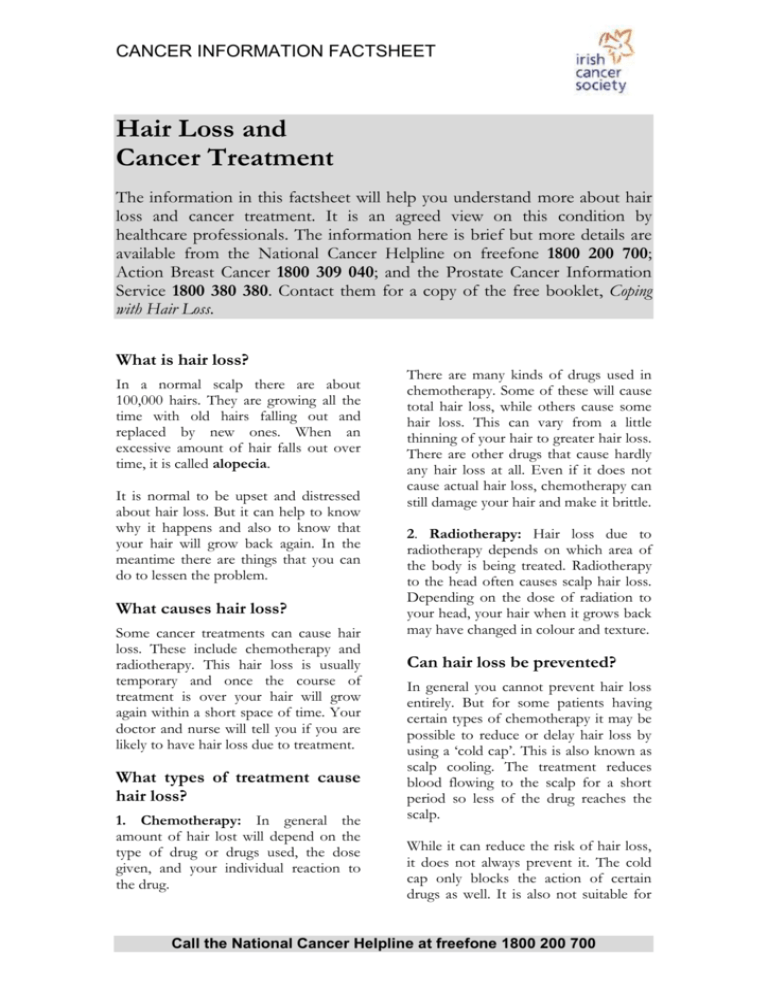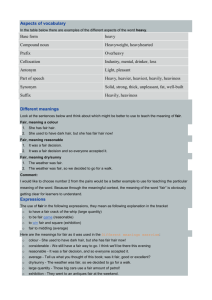Hair loss and cancer treatment
advertisement

CANCER INFORMATION FACTSHEET Hair Loss and Cancer Treatment The information in this factsheet will help you understand more about hair loss and cancer treatment. It is an agreed view on this condition by healthcare professionals. The information here is brief but more details are available from the National Cancer Helpline on freefone 1800 200 700; Action Breast Cancer 1800 309 040; and the Prostate Cancer Information Service 1800 380 380. Contact them for a copy of the free booklet, Coping with Hair Loss. What is hair loss? In a normal scalp there are about 100,000 hairs. They are growing all the time with old hairs falling out and replaced by new ones. When an excessive amount of hair falls out over time, it is called alopecia. It is normal to be upset and distressed about hair loss. But it can help to know why it happens and also to know that your hair will grow back again. In the meantime there are things that you can do to lessen the problem. What causes hair loss? Some cancer treatments can cause hair loss. These include chemotherapy and radiotherapy. This hair loss is usually temporary and once the course of treatment is over your hair will grow again within a short space of time. Your doctor and nurse will tell you if you are likely to have hair loss due to treatment. What types of treatment cause hair loss? 1. Chemotherapy: In general the amount of hair lost will depend on the type of drug or drugs used, the dose given, and your individual reaction to the drug. There are many kinds of drugs used in chemotherapy. Some of these will cause total hair loss, while others cause some hair loss. This can vary from a little thinning of your hair to greater hair loss. There are other drugs that cause hardly any hair loss at all. Even if it does not cause actual hair loss, chemotherapy can still damage your hair and make it brittle. 2. Radiotherapy: Hair loss due to radiotherapy depends on which area of the body is being treated. Radiotherapy to the head often causes scalp hair loss. Depending on the dose of radiation to your head, your hair when it grows back may have changed in colour and texture. Can hair loss be prevented? In general you cannot prevent hair loss entirely. But for some patients having certain types of chemotherapy it may be possible to reduce or delay hair loss by using a ‘cold cap’. This is also known as scalp cooling. The treatment reduces blood flowing to the scalp for a short period so less of the drug reaches the scalp. While it can reduce the risk of hair loss, it does not always prevent it. The cold cap only blocks the action of certain drugs as well. It is also not suitable for Call the National Cancer Helpline at freefone 1800 200 700 Information factsheet on hair loss and cancer treatment all patients and not all hospitals offer this kind of treatment. Ask your doctor or nurse if it would be useful for you. How soon will my hair fall out? If hair loss does occur, it usually happens within a few weeks of the start of treatment. It can help to have your hair cut short before treatment or soon after it begins. The weight of long hair can pull on the scalp and may make your hair fall out faster. You may experience tingling or sensitivity of your scalp just before your hair starts to falls out. This is normal and may last a day or so. Hair loss when it happens is usually gradual. It can fall out in clumps when shampooing or brushing. Sometimes you may find clumps of hair on your pillow or on your hairbrush. At this time you may prefer to shave off your hair entirely. Underarm, body and pubic hair may be lost as well. Some drugs also cause loss of your eyelashes and eyebrows. How should I care for my hair during treatment? Your scalp may feel very sensitive to washing, combing or brushing during the short time when your hair is actually falling out. Brush or comb your hair gently – use a soft or baby brush. Use gentle hair products. Use a gentle unperfumed moisturiser on your scalp if it becomes dry or itchy. Natural oils such as almond oil or olive oil are suitable. Often plain face creams can help. Avoid using hair dryers, curling tongs and curlers. Pat your hair gently after washing it. Do not perm or straighten your hair during chemotherapy. 2 If you colour your hair, use a very mild vegetable-based colour. Ask your nurse or hairdresser for more advice. When will my hair grow back? In general hair grows back within a few weeks of finishing treatment. In some cases it can start to regrow even before treatment has finished. When it does grow back, it can often be a different texture, style and colour. You may notice it is thicker and darker in colour. At first, fine downy hair appears on your scalp, then stronger hair develops and grows at half an inch each month. Emotional and psychological effects of hair loss It is natural to feel upset at the thought of losing your hair. For some people this can be one of the hardest things to cope with during treatment. You may feel that by losing your hair you are also losing your identity. Don’t be afraid to talk to your nurse or medical social worker about your feelings. He or she will help you find ways to deal with your hair loss. If your hospital does not have a medical social worker, your healthcare team can still give you advice and arrange further emotional or psychological support if needed. If you prefer, you can also contact the National Cancer Helpline 1800 200 700. At the hospital, your nurse or a member of your healthcare team will be able to advise you about getting a wig or hairpiece. Having a hairpiece that matches the colour, texture, style and shape of your own hair can make you feel more like yourself. If your hospital does not have a medical social worker, ask your nurse for the names of wig fitters that you could visit. For more information and advice, call the National Cancer Helpline 1800 200 Call the National Cancer Helpline at freefone 1800 200 700 Information factsheet on hair loss and cancer treatment 700 and also for a copy of the booklet, Coping with Hair Loss. Advice for when choosing a hairpiece Bring a friend or relative with you to the wig supplier, preferably one that is interested in helping you find a hairpiece that suits you best. Visit a supplier before you lose your hair, even if you are not sure you will need or want a hairpiece. That way you can get as close a match to the colour and texture of your own hair. If this is not possible, bring a recent photograph of your full head of hair. Give yourself plenty of time to decide on a hairpiece that suits you best. If you are unsure, leave it and come back a second time. What are hairpieces made of? Wigs and hairpieces are made of either manmade fibres or real human hair. There are advantages and disadvantages to both types, so neither one is better than the other. It often comes down to personal preference. Fibre wigs can come in a huge variety of styles and colours and are easier to care for in general, but may not have a ‘natural’ look and need to be replaced more often. Human hair looks more natural and can last longer, but is more expensive. These wigs need more care than fibre wigs and must be styled after every wash. Where can I buy a hairpiece? Your nurse may be able to give you a list of wig suppliers in your local area. The Irish Cancer Society has a list of suppliers nationwide that you can contact. Choose a wig supplier that has a special fitting service and a big selection of wigs. It helps if you are given plenty of time to fit on the wigs in a private room with lots of natural light. If you 3 are unable to visit their shop, some wig suppliers offer home and hospital fittings too. Some can arrange to cut your hair before, during or after treatment. How much do hairpieces cost? The price of wigs and hairpieces can vary a good deal from company to company. The average price of a fibre wig is between €300 and €480. For human hair it can vary between €600 and €900. When checking prices, it is always good to shop around. Am I entitled to free hairpieces? In general you are only entitled to free hairpieces if you have a medical card. Medical card holders: If you have a medical card, you are entitled to 1–2 free or subsidised hairpieces every year. The subsidy can vary from €350 to €650 and will depend on the HSE area in which you live. The subsidy will also vary depending on the type of hairpiece you chose. Before buying the wig, your nurse can give you a letter saying the wig is for medical reasons. No health cover: If you do not have a medical card or private insurance, you can claim tax back on any hairpieces you buy. Because hairpieces are regarded as a medical expense, you will need to complete the MED1 form when doing so. For more details contact your local tax office (Revenue Commissioners). Medical insurance: Some medical insurers, e.g. the VHI, will cover a certain amount of the cost of a hairpiece, depending on the type of cover you have. It covers the cost of up to two hairpieces every year and accessories. If your insurance does not cover the cost, you can claim it back as a medical expense on the MED1 form. Call the National Cancer Helpline at freefone 1800 200 700 Information factsheet on hair loss and cancer treatment BUPA will cover the full cost of one hairpiece every year. This is regardless of which insurance cover you have. If I don’t want a hairpiece, what else can I wear? There are many other types of headwear available. You can choose from scarves and bandanas to turbans and soft hats. There are also night caps or sleep hats that can be worn for warmth and comfort in bed. Thin quilted cotton headliners are also available, which give height and shape when worn under hats and scarves. They also give an extra layer of warmth day or night. Nowadays headwear comes in many attractive designs and can fit your head fully and securely. In general cotton headwear tends to stay on your smooth scalp better than nylon or polyester. If you feel that your face looks bare, there are also hair fringes, plaited braids and face-framers that can be worn with headwear to give the effect of hair beneath. If you decide not to cover your head, make sure you apply a high protection suncream at all times. When is it safe to perm or dye my hair again? After chemotherapy or radiotherapy, your hair may take a while to get back to its normal condition. It is best to wait for at least 6 months after treatment. Once it is long enough and your hair and scalp are in good condition you can tint or perm your hair. Do not perm or colour your hair if: your scalp is scaly, sore or irritated your hair is drier than usual your hair is rough to the touch your hair is lighter in colour than before your treatment 4 your hair appears to be breaking or not growing normally. Ask your hairdresser for advice on natural products such as henna or vegetable-based dyes. Test the dye on a small, hidden area of hair first to make sure that it will not damage your hair. Donating hair Sometimes the friends and relatives of those with cancer would like to donate their hair for wigs for cancer patients. At present there are no organisations in Ireland that accept human hair donations. However, there are organisations in the UK, the USA and Canada which do accept donations. Contact the National Cancer Helpline 1800 200 700 for more details. Further information For more information on cancer and hair loss, call the National Cancer Helpline on Freefone 1800 200 700 (Monday–Friday, 9am – 5pm, Tuesdays 9am – 9pm) or email helpline@irishcancer.ie for confidential advice from our cancer nurse specialists. Action Breast Cancer 1800 309 040 Prostate Cancer Information Service 1800 380 380 Irish Cancer Society 43/45 Northumberland Road Dublin 4 Website: www.cancer.ie Call the National Cancer Helpline at freefone 1800 200 700 Information factsheet on hair loss and cancer treatment Useful organisations Health insurers Dept of Social and Family Affairs – Information Service Áras Mhic Dhiarmada, Store Street Dublin 1 Tel: 01 874 8444 Email: info@welfare.ie Website: www.welfare.ie BUPA Ireland Mill Island, Fermoy, Co Cork Locall: 1890 700 890 Email: choices@bupa.ie Website: www.bupa.ie Heath Service Executive (HSE) National information line: 1850 241 850 Email: info@hse.ie Website: www.hse.ie Look Good Feel Better 44/45 Northumberland Road, Dublin 4 Tel: 01 231 0520 This is an international programme that gives practical advice to men and women to help them deal with some side-effects of cancer treatment, including hair loss. VIVAS Health Paramount Court, Corrig Road, Sandyford, Dublin 18 Tel: 1850 717 717 Email: support@vivashealth.ie Website: www.vivashealth.ie Voluntary Health Insurance (VHI) VHI House, Lower Abbey Street Dublin 1 Locall: 1850 444 444 Email: info@vhi.ie Website: www.vhi.ie Revenue Commissioners Border Midlands West region: Locall 1890 777 425 Email: bmwregion@revenue.ie Dublin region: Locall 1890 333 425 Email: dublinregoff@revenue.ie South West region: Locall 1890 222 425 Email: swregoffice@revenue.ie East and South East region: Locall 1890 444 425 Email: eseregionaloffice@revenue.ie Website: www.revenue.ie © Irish Cancer Society, 2006 Call the National Cancer Helpline at freefone 1800 200 700 5








